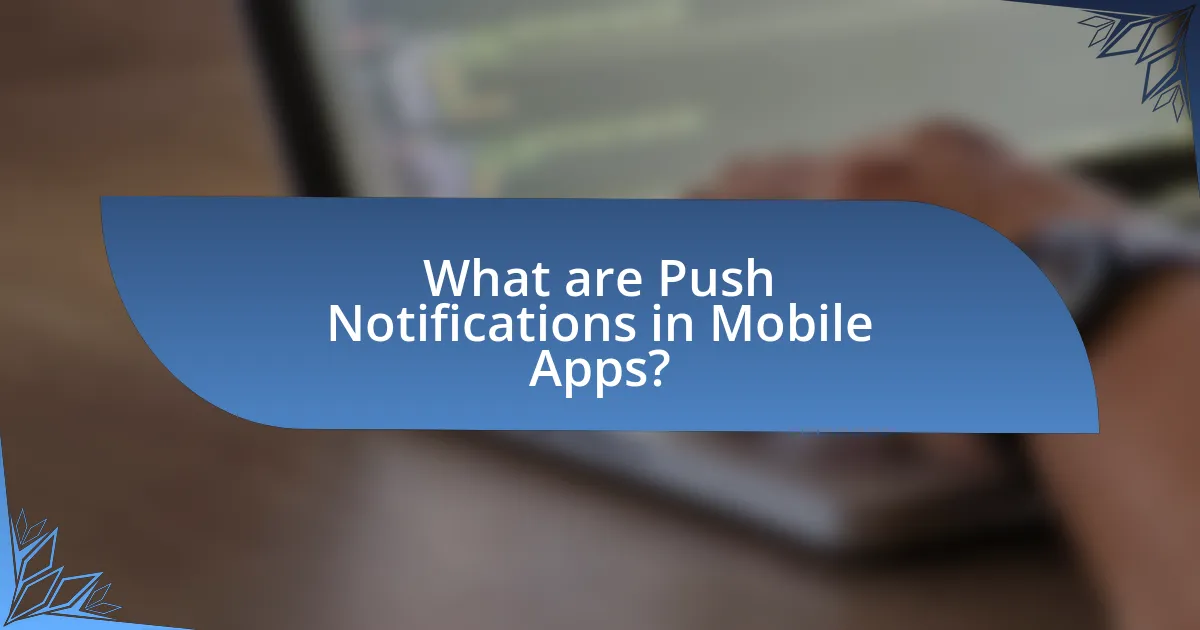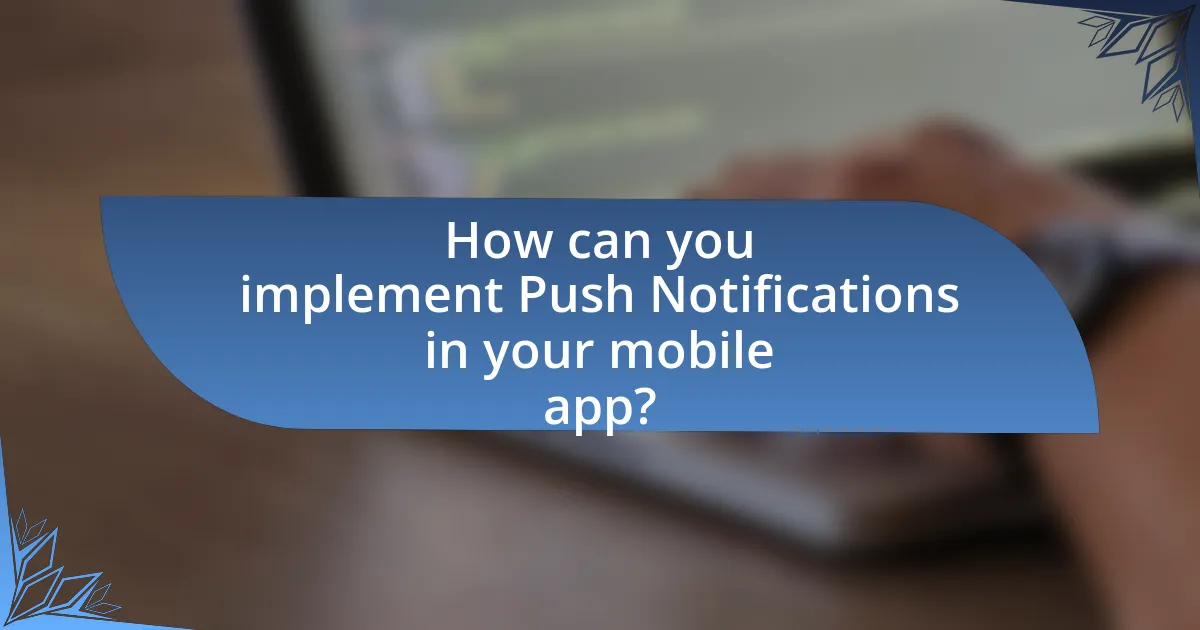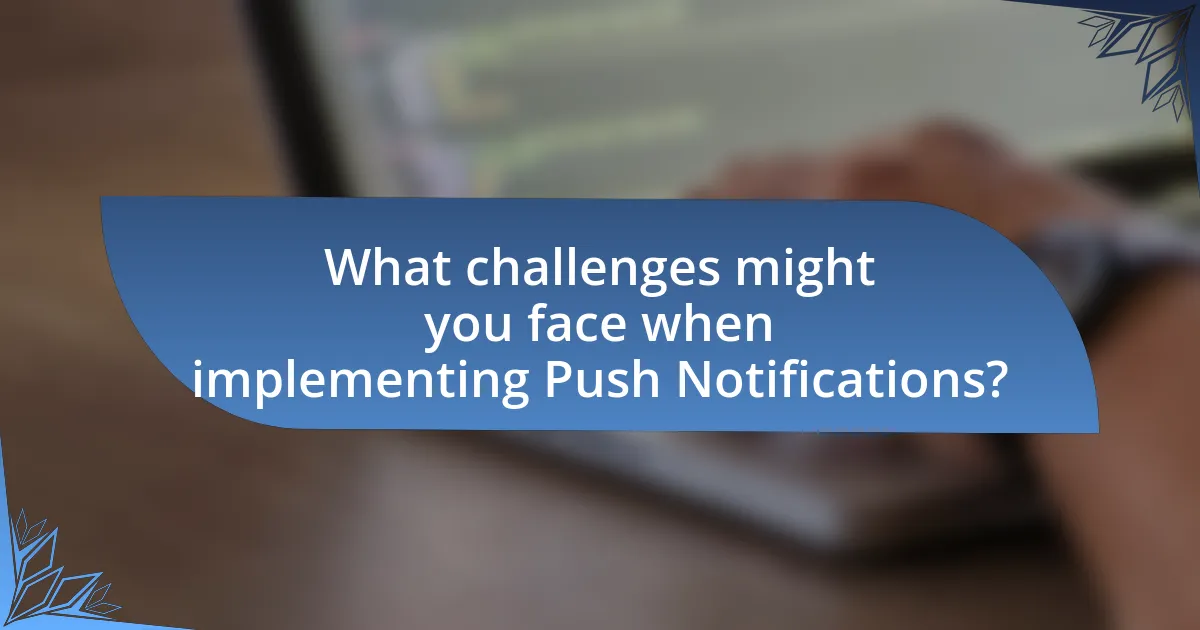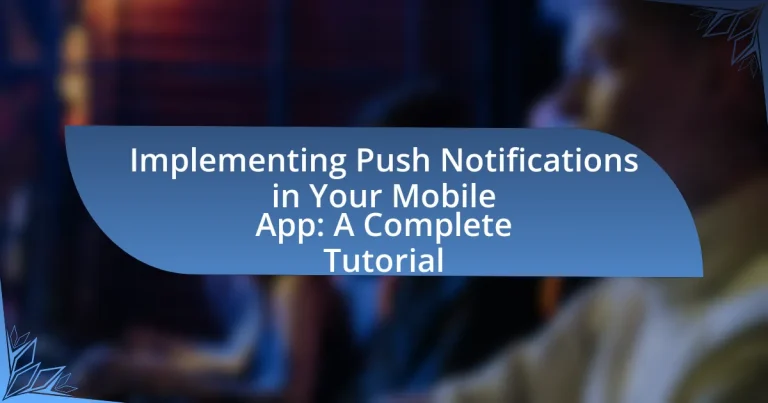Push notifications are essential messages sent by mobile applications to users’ devices, even when the app is not in use, significantly enhancing user engagement and retention. This article provides a comprehensive tutorial on implementing push notifications in mobile apps, detailing their functionality, key components, and advantages. It covers the steps for setup, best practices for effective use, and tools available for monitoring and optimizing push notification strategies. Additionally, it addresses common challenges and troubleshooting tips to ensure reliable delivery and measure success through relevant metrics.

What are Push Notifications in Mobile Apps?
Push notifications in mobile apps are messages sent by an application to a user’s device, even when the app is not actively in use. These notifications serve various purposes, such as alerting users about new content, updates, or reminders, thereby enhancing user engagement and retention. According to a report by Localytics, apps that utilize push notifications can see a 20% increase in user engagement, demonstrating their effectiveness in maintaining user interest and interaction with the app.
How do Push Notifications function within mobile applications?
Push notifications function within mobile applications by utilizing a messaging service that allows apps to send alerts and updates to users even when the app is not actively in use. This process involves a push notification service, such as Apple Push Notification Service (APNs) for iOS or Firebase Cloud Messaging (FCM) for Android, which facilitates the delivery of messages from the server to the user’s device. When a user opts in to receive notifications, the app registers with the push notification service, obtaining a unique device token. The server then sends messages to this token, which the service delivers to the device, prompting the app to display the notification to the user. This mechanism enables real-time communication and engagement, as evidenced by studies showing that push notifications can increase user retention by up to 88% when used effectively.
What are the key components of a Push Notification system?
The key components of a Push Notification system include a Push Notification Service, a client application, and a backend server. The Push Notification Service, such as Firebase Cloud Messaging or Apple Push Notification Service, facilitates the delivery of messages to devices. The client application is responsible for receiving and displaying notifications to users, while the backend server manages the logic for sending notifications, including user targeting and message content. These components work together to ensure timely and relevant communication with users, enhancing user engagement and retention in mobile applications.
How do mobile devices receive and display Push Notifications?
Mobile devices receive and display push notifications through a combination of a push notification service and the device’s operating system. When a mobile app wants to send a notification, it communicates with a push notification service, such as Apple’s APNs or Google’s FCM, which then routes the notification to the appropriate device. The device’s operating system processes the incoming notification and displays it to the user, typically in the notification center or as a banner alert. This process is supported by the use of unique device tokens that identify each device to the push notification service, ensuring that notifications are delivered accurately and promptly.
What advantages do Push Notifications provide for mobile apps?
Push notifications provide mobile apps with enhanced user engagement, improved retention rates, and timely communication. These notifications allow apps to deliver real-time updates, reminders, and personalized content directly to users, which can significantly increase interaction. According to a study by Localytics, apps that utilize push notifications see a 50% higher engagement rate compared to those that do not. Additionally, push notifications can lead to a 20% increase in app retention, as they remind users of the app’s value and encourage regular use.
How can Push Notifications enhance user engagement?
Push notifications enhance user engagement by delivering timely and relevant information directly to users’ devices, prompting immediate interaction. Research indicates that apps utilizing push notifications can see engagement rates increase by up to 88%, as users are more likely to return to an app when they receive personalized alerts. This direct communication fosters a sense of connection and encourages users to engage with content, promotions, or updates, ultimately leading to higher retention rates and increased user activity within the app.
What impact do Push Notifications have on user retention rates?
Push notifications significantly enhance user retention rates by providing timely and relevant information that encourages users to engage with an app. Studies indicate that apps utilizing push notifications can see retention rates increase by up to 88% compared to those that do not use them. This increase is attributed to the ability of push notifications to remind users of the app’s value, promote new features, and re-engage users who may have become inactive. Furthermore, a report by Localytics found that users who opt-in to receive push notifications are 4 times more likely to return to an app than those who do not.

How can you implement Push Notifications in your mobile app?
To implement push notifications in your mobile app, you need to integrate a push notification service such as Firebase Cloud Messaging (FCM) or Apple Push Notification Service (APNs). First, register your app with the chosen service to obtain the necessary credentials, such as API keys or certificates. Next, incorporate the service’s SDK into your app’s codebase, enabling it to receive notifications. After that, configure your server to send notifications by using the service’s API, ensuring that you handle user permissions for notifications within the app. Finally, test the implementation to confirm that notifications are received correctly on target devices. This process is validated by the widespread use of FCM and APNs in mobile applications, demonstrating their effectiveness in delivering timely notifications to users.
What are the steps to set up Push Notifications?
To set up Push Notifications, follow these steps: First, choose a push notification service, such as Firebase Cloud Messaging (FCM) or OneSignal. Next, integrate the chosen service into your mobile app by adding the necessary SDK and configuring the app settings. After integration, register the device to receive notifications by obtaining a unique device token. Then, create a backend server to send notifications, ensuring it communicates with the push notification service. Finally, test the push notifications by sending a sample notification to verify that the setup is functioning correctly. These steps are essential for effectively implementing push notifications in a mobile application.
Which platforms support Push Notifications and how do they differ?
Several platforms support Push Notifications, including iOS, Android, and web browsers. iOS utilizes Apple Push Notification Service (APNs), which allows developers to send notifications to iPhone and iPad users. Android employs Firebase Cloud Messaging (FCM), enabling notifications for Android devices and web applications. Web browsers like Chrome and Firefox support Push Notifications through the Push API, allowing notifications to be sent to users even when the browser is not open. The differences lie in their implementation and capabilities; for instance, APNs requires a unique device token for each device, while FCM uses a registration token that can be reused across multiple devices. Additionally, APNs supports rich notifications with images and actions, whereas FCM provides more flexibility in targeting specific user segments.
What tools and services can assist in implementing Push Notifications?
Firebase Cloud Messaging (FCM) is a leading tool for implementing push notifications, providing a reliable and scalable solution for sending messages to users across Android, iOS, and web applications. FCM supports various features such as message targeting, analytics, and user engagement metrics, making it a comprehensive choice for developers. Additionally, OneSignal offers a user-friendly platform that simplifies the process of managing push notifications, including segmentation and A/B testing capabilities. Another option is Pusher Beams, which focuses on real-time notifications and provides SDKs for multiple programming languages, ensuring seamless integration. These tools are widely recognized in the industry for their effectiveness and ease of use in implementing push notifications.
What are the best practices for using Push Notifications effectively?
The best practices for using push notifications effectively include personalizing messages, timing notifications appropriately, and limiting frequency to avoid user fatigue. Personalization increases engagement; for instance, tailored messages can lead to a 4.5 times higher click-through rate, as reported by Localytics. Timing is crucial; sending notifications during peak user activity times can enhance visibility and interaction. Additionally, limiting the number of notifications prevents overwhelming users, which can lead to uninstalls; research indicates that 60% of users opt out of notifications due to excessive messaging. Implementing these strategies can significantly improve user engagement and retention.
How can you personalize Push Notifications for better user experience?
Personalizing push notifications enhances user experience by tailoring messages based on user behavior, preferences, and demographics. By analyzing user data, such as past interactions and preferences, developers can create targeted notifications that resonate with individual users. For instance, a study by Localytics found that personalized push notifications can increase engagement rates by up to 800%. This data underscores the effectiveness of personalization in driving user interaction and satisfaction.
What frequency of Push Notifications is considered optimal?
The optimal frequency of push notifications is generally considered to be between one to three notifications per week. This frequency balances user engagement without overwhelming them, as studies indicate that excessive notifications can lead to higher unsubscription rates and user fatigue. Research by Localytics shows that apps sending one to three notifications per week have a 50% higher retention rate compared to those sending more than five notifications weekly.

What challenges might you face when implementing Push Notifications?
When implementing push notifications, developers may face challenges such as user opt-in rates, message relevance, and platform-specific restrictions. Low opt-in rates can hinder the effectiveness of push notifications, as users may be reluctant to allow notifications due to privacy concerns or notification fatigue. Additionally, ensuring that messages are relevant and personalized is crucial; irrelevant notifications can lead to user disengagement and increased unsubscription rates. Furthermore, different platforms, such as iOS and Android, have specific guidelines and limitations regarding push notifications, which can complicate implementation. For instance, Apple requires explicit user consent for notifications, while Android allows more flexibility but has its own set of best practices. These challenges necessitate careful planning and strategy to optimize the push notification experience for users.
How can you troubleshoot common issues with Push Notifications?
To troubleshoot common issues with push notifications, first ensure that the device settings allow notifications from the app. If notifications are disabled, users will not receive them. Next, verify that the app is correctly configured to receive push notifications, including checking the API keys and server settings. Additionally, confirm that the device is connected to the internet, as a lack of connectivity can prevent notifications from being delivered.
If notifications still do not appear, check the notification payload for errors, ensuring that the format is correct and that all required fields are included. Testing with different devices and operating systems can also help identify if the issue is device-specific. Finally, consult the documentation of the push notification service being used, as it often contains troubleshooting tips specific to that service.
What are the most frequent errors encountered during implementation?
The most frequent errors encountered during the implementation of push notifications in mobile apps include misconfigured server settings, incorrect API keys, and failure to handle user permissions properly. Misconfigured server settings can lead to notifications not being sent or received, while incorrect API keys can prevent successful communication between the app and the notification service. Additionally, failure to request and manage user permissions can result in users not receiving notifications, as they may have denied permission without the app handling this scenario appropriately. These errors are commonly reported in developer forums and documentation, highlighting their prevalence in the implementation process.
How can you ensure reliable delivery of Push Notifications?
To ensure reliable delivery of push notifications, implement a robust infrastructure that includes using a reliable push notification service, optimizing payload size, and ensuring proper device token management. A reliable push notification service, such as Firebase Cloud Messaging or Apple Push Notification Service, provides high availability and scalability, which are essential for consistent delivery. Optimizing payload size minimizes the risk of notifications being dropped due to size limits imposed by platforms; for instance, both iOS and Android have specific size constraints. Additionally, maintaining an updated database of device tokens is crucial, as invalid or outdated tokens can lead to failed deliveries. According to a study by Localytics, push notifications can increase app engagement by up to 88%, highlighting the importance of ensuring their reliability for user retention.
What metrics should you track to measure the success of Push Notifications?
To measure the success of Push Notifications, track metrics such as open rates, click-through rates (CTR), conversion rates, and opt-out rates. Open rates indicate how many users engaged with the notification, while CTR measures the percentage of users who clicked on the notification. Conversion rates reflect the percentage of users who completed a desired action after clicking, and opt-out rates show how many users chose to unsubscribe from notifications. According to a study by Localytics, push notifications can increase app engagement by up to 88%, highlighting the importance of these metrics in evaluating effectiveness.
How can you analyze user engagement with Push Notifications?
To analyze user engagement with push notifications, utilize metrics such as open rates, click-through rates (CTR), and conversion rates. Open rates indicate how many users engaged with the notification, while CTR measures the percentage of users who clicked on the notification. Conversion rates track the actions users take after clicking, such as making a purchase or signing up for a service. According to a study by Localytics, push notifications can increase app engagement by up to 88%, highlighting their effectiveness in driving user interaction. By systematically tracking these metrics, developers can assess the impact of push notifications on user behavior and optimize their strategies accordingly.
What tools can help you monitor the effectiveness of your Push Notification strategy?
Tools that can help monitor the effectiveness of your Push Notification strategy include Google Analytics, OneSignal, and Airship. Google Analytics provides insights into user engagement and conversion rates, allowing you to track how push notifications influence user behavior. OneSignal offers detailed analytics on delivery rates, open rates, and engagement metrics, enabling you to assess the performance of individual notifications. Airship, formerly Urban Airship, provides comprehensive reporting features that analyze user interactions and retention, helping you optimize your push notification campaigns. These tools collectively offer data-driven insights that validate the effectiveness of your push notification strategy.
What are some practical tips for optimizing Push Notifications in your app?
To optimize push notifications in your app, focus on personalization, timing, and frequency. Personalization increases engagement; for instance, tailored messages can boost open rates by 26% according to a study by Localytics. Timing is crucial; sending notifications when users are most active can enhance interaction, with research indicating that notifications sent during peak usage times yield higher response rates. Additionally, maintaining an optimal frequency prevents user fatigue; studies show that excessive notifications can lead to uninstalls, with 60% of users opting out due to annoyance. Implementing these strategies can significantly improve the effectiveness of push notifications in your app.


